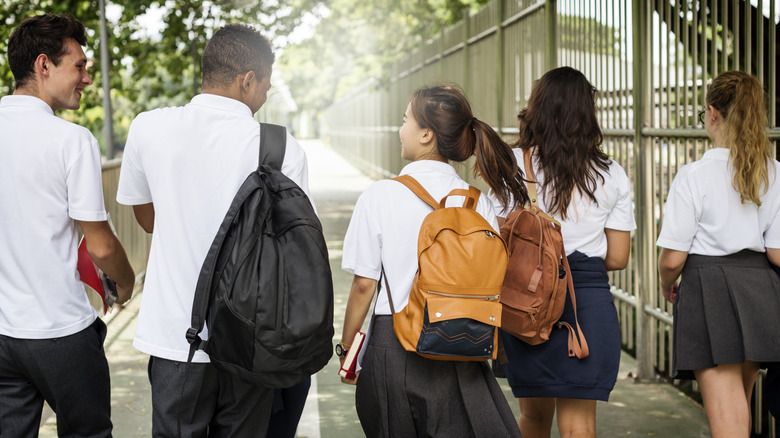The Good And The Bad About Requiring School Uniforms
Back-to-school season may have passed, but there's one topic that never goes off-trend — the school uniform debate. Whether or not to implement school uniforms is a rather touchy subject in the United States. Though school uniforms have long been implemented in countries like the United Kingdom, Australia, and across Asia (via Insider), U.S. schools have never taken large steps toward requiring uniforms.
The school uniform debate has been going on for a while, but with some schools implementing online dress codes during the height of the pandemic — a decision that received major backlash from parents — it seems it may be flaring up once more. Interestingly, as reported by Quartz, U.S. public schools that required uniforms were up by 21.5% in 2016, compared to just 13.8% ten years before.
Though many schools have their own version of a uniform, commonly referred to as a dress code, a uniform is something that unites everybody, for good or bad. Can a school uniform really improve attendance and create less insecurity, or is it a surefire way to suppress individuality and cause contention?
School uniforms can bring added benefits for students
There are many pros to wearing a school uniform. One of the main reasons is that — with an enforced school uniform — in principle, everybody is on the same level. According to Verywell Family, children and teens use style as a way to compare themselves to their peers, which can cause low self-esteem and insecurities. The added pressure of buying name-brand or more expensive items can also make schoolchildren feel inadequate. A school uniform would prevent this on some level as everybody has to wear the same thing.
Another benefit of school uniforms is that it can have cause students to put in more effort with work and study. This is a consequence of not being distracted by what they and others are wearing (via Britannica). School uniforms additionally have the potential to improve attendance and punctuality due to the fact students don't have to pick an outfit and can instead just put on their uniform and leave the house.
Finally, as outlined by Independent Education Today, school uniforms are a good way to get students adjusted for their future working lives, where many will have to wear some sort of uniform.
They can be a cause of contention for various reasons, too
However, a major drawback of school uniforms is that they can often be expensive to buy (via Independent Education Today). Pieces like shirts and blazers often need to be replaced each year as your child grows, which could cause financial stress and worry. Though name-brand clothing can be expensive, it can also often be found discounted or thrifted, whereas uniforms cannot.
Plus, per Britannica, children may feel quashed and as though they aren't able to express themselves well whilst wearing a school uniform because of the lack of individuality a uniform allows. Moreover, a huge drawback of uniforms is that they can actually cause more insecurity. Everyone looks different in a school uniform, meaning comparison and negative self-image could still occur.
School uniforms can improve concentration, reduce insecurity over dressing well, and prepare students for working life. On the other hand, they could make students feel as though their identity is being erased, especially if a uniform is introduced in the middle of their education. If planning to introduce school uniforms, talks should be held with students and parents to decide the best outcome before implementing such a large change.


